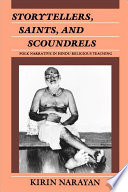
Swamiji, a Hindu holy man, is the central character of Storytellers, Saints, and Scoundrels. He reclines in a deck chair in his modern apartment in western India, telling subtle and entertaining folk narratives to his assorted gatherings. Among the listeners is Kirin Narayan, who knew Swamiji when she was a child in India and who has returned from America as an anthropologist. In her book Narayan builds on Swamiji's tales and his audiences' interpretations to ask why religious teachings the world over are so often couched in stories. For centuries, religious teachers from many traditions have used stories to instruct their followers. When Swamiji tells a story, the local barber rocks in helpless laughter, and a sari-wearing French nurse looks on enrapt. Farmers make decisions based on the tales, and American psychotherapists take notes that link the storytelling to their own practices. Narayan herself is a key character in this ethnography. As both a local woman and a foreign academic, she is somewhere between participant and observer, reacting to the nuances of fieldwork with a sensitivity that only such a position can bring. Each story s reproduced in its evocative performance setting. Narayan supplements eight folk narratives with discussions of audience participation and response as well as relevant Hindu themes. All these stories focus on the complex figure of the Hindu ascetic and so sharpen our understanding of renunciation and gurus in South Asia. While Storytellers, Saints, and Scoundrels raises provocative theoretical issues, it is also a moving human document. Swamiji, with his droll characterizations, inventive mind, and generous spirit, is a memorable character. The book contributes to a growing interdisciplinary literature on narrative. It will be particularly valuable to students and scholars of anthropology, folklore, performance studies, religions, and South Asian studies